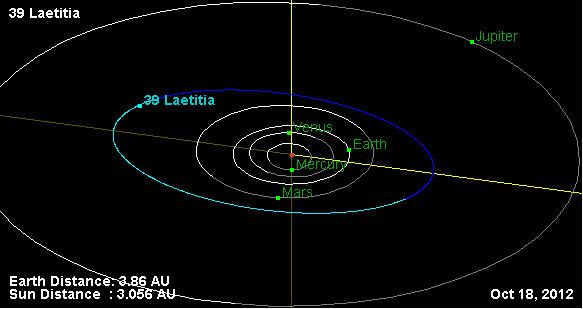Discovered by J. Chacornac Minor planet category Main belt Perihelion 366.877 Gm (2.452 AU) Discovered 8 February 1856 Discovery site Paris Observatory | Discovery date February 8, 1856 Aphelion 461.503 Gm (3.085 AU) Semi-major axis 414.190 Gm (2.769 AU) Asteroid group Asteroid belt | |
 | ||
Similar Jean Chacornac discoveries, Other celestial objects | ||
39 Laetitia /lᵻˈtiːʃiə/ is a large main-belt asteroid that was discovered by French astronomer Jean Chacornac on February 8, 1856, and named after Laetitia, a minor Roman goddess of gaiety.
Photometric observations of this asteroid gathered between 1968–74 were used to build a light curve that provided shape and rotation information. It has the general shape of an elongated triaxial ellipsoid with ratios between the lengths of the axes equal to 15:9:5. Major surface features are on a scale of 10 km and the surface color does not vary significantly across the surface. In the ecliptic coordinate system, the pole of rotation is estimated to be oriented to the coordinates (λ0, β0) = (121° ± 10°, +37° ± 10°).
In 1988 a search for satellites or dust orbiting this asteroid was performed using the UH88 telescope at the Mauna Kea Observatories, but the effort came up empty. Photometric observations collected during 2006–08 were used to measure time variations of the asteroid light curve. This data suggests that the asteroid may have a complex shape or it could be a binary asteroid system. Observations of an occultation on March 21, 1998, produced several chords indicating an ellipsoidal cross-section of 219 × 142 km.
